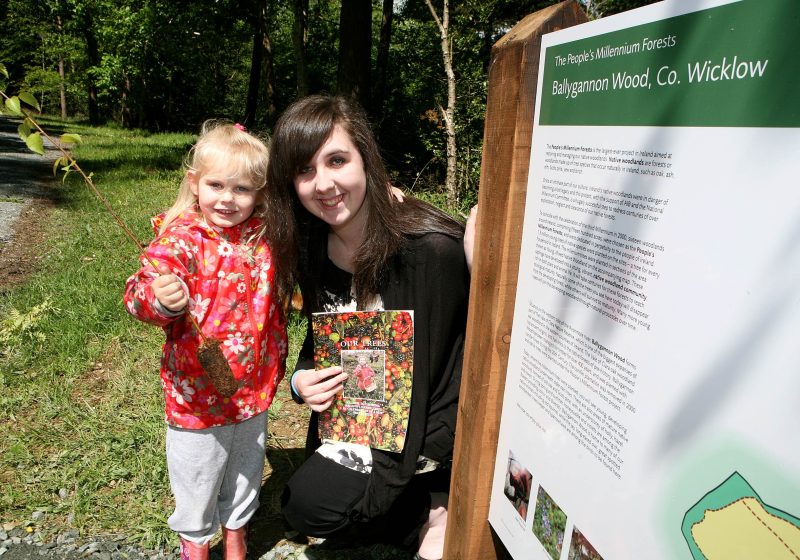Potential Benefits
The appropriate, sustainable management and expansion of native woodlands is the ultimate objective of all these activities so that future generations will have the opportunity to experience their beauty and diversity.
Vision
As part of our natural culture since the retreat of the ice sheets over 10,000 years ago, it is imperative that we ensure the protection and viability of native woodlands and the unique animal and plant communities that live in them. It is also important that Woodlands of Ireland raises awareness and encourages an appreciation of native woodlands amongst the general public. This will almost certainly foster a caring attitude and result in additional multiple benefits including educational, cultural, recreational and health.

Sorcha Parker (holding a copy of 'Our Trees' where she featured on the cover in 2000 when this book was first published) with another generation of enthusiastic children at the 10 year People's Millennium Forests Project anniversary celebration event held at Ballygannon in May 2011
Linkage with Commercial Forestry
Native woodlands, through joint management and research initiatives, also provide valuable information to the wider forestry sector, which are used in sustainable development and management strategies for commercial forest plantations. Specifically, the diversification of tree species, management of aqautic buffer zones, novel mitigation measures in commercial forestry to reduce negative impacts, and biodiversity enhancement actions are facilitated through research and woodland management projects. The incorporation of nature-oriented management techniques in commercial forestry is occurring in other European countries, particularly Germany, Austria and Finland. These practices have gained increasing importance as a result of recent international conventions and protocols. Many countries are adopting the guidelines on sustainable management and biodiversity laid down by the Helsinki Process, and are endeavouring to comply with the Convention on Biological Diversity.
Native Woodlands: Conservation and Wood Production
Conservationists and foresters alike are beginning to recognise that it is possible to conserve most native woodlands, while at the same time managing them for wood production. For centuries, they have been doing this in Central European countries, where selective felling is practised in forests without significantly affecting woodland cover (a practise that is promoted by others such as Prosylva Ireland). In many cases, these European woodlands owe their very survival to their long-term management. Thus, the future management of our native woodlands should also include, where feasible and appropriate, a commercial wood production element. This is also imperative during lean times when grant aid is restricted and where economic sustainability will be a crucial component in the long term viability of native woodlands through active management. However, a selection of high biodiversity value woodland communities, which are representative of all the native woodland types that exist in Ireland today, i.e. acid oak, ash, ash-oak-hazel, riparian types, yew woodland, etc., should be set-aside for conservation and research purposes only.
Spin-offs
The successful implementation of the Woodlands of Ireland work programme helps to create a sense of identity in the general public with native woodlands. In addition, spin-offs include educational, ecological, sustainable commercial forest practices and indigenous enterprises comprising small wood-based industries with sustainable jobs. Government involvement, especially through financial support, provides the impetus and publicity required to involve as many people as possible through genuine consultation and engagement. It gives the project its own distinctive identity, providing an umbrella for all the factors concerned, including social, cultural, scientific and educational elements. Full community involvement is encouraged and incorporates a North-South dimension, in partnership format, that will realise a vision of our native woodlands as a multi-functional resource for the people of Ireland. This project is for all Irish people, at home and abroad, who will look back to the early years of this new millennium, when a positive statement was acted upon, signifying the development and rehabilitation of our native woodlands for the benefit of future generations.